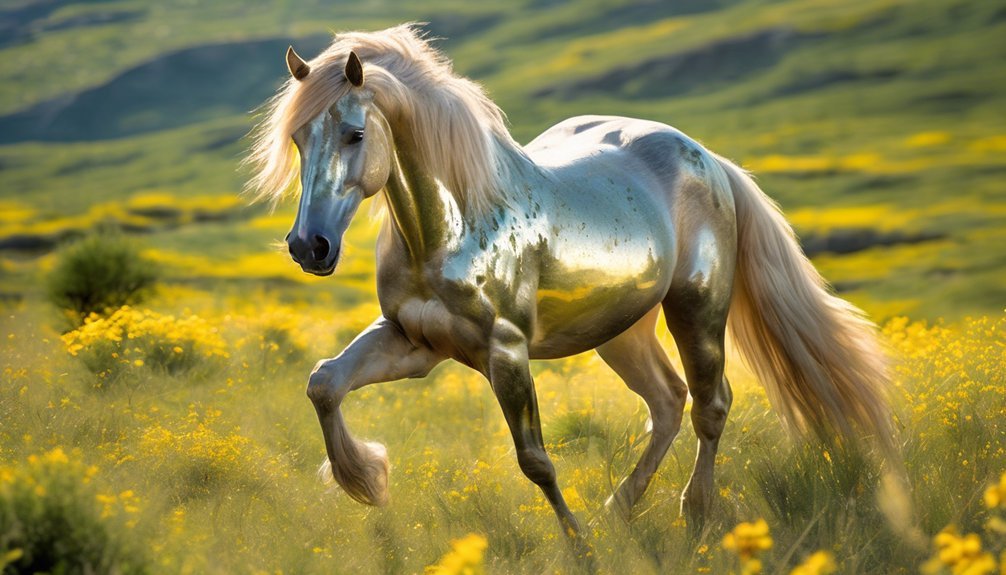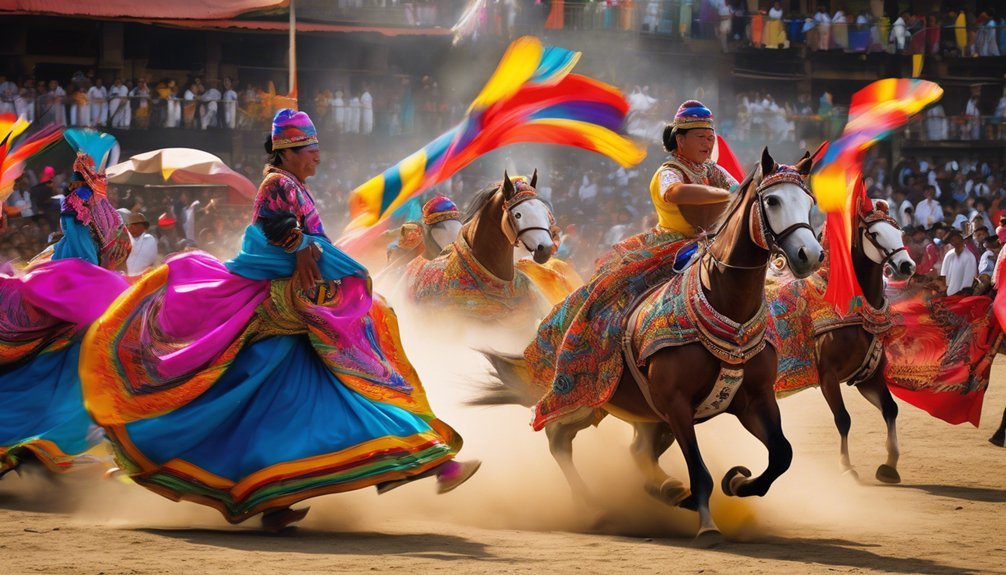
On farms and ranches, the relationship between horses and dogs is more than just functional; it's a partnership built on trust and cooperation. Each animal plays a unique role, with horses providing strength and mobility, while dogs excel in herding and protection. Understanding their dynamics is crucial for enhancing productivity and harmony. As we explore this relationship, you'll discover how effective communication and training techniques can deepen their bond and improve farm operations.
Key Takeaways
- Horses provide strength for plowing and transporting goods, while dogs excel in herding and protecting livestock on farms.
- The bond between horses and dogs enhances operational efficiency, reducing workload through effective teamwork.
- Training techniques like trust exercises and positive reinforcement foster cooperation and strengthen relationships between horses and dogs.
- Understanding each species' body language promotes harmony and reduces stress, allowing for safer interactions on the farm.
- Designated safe areas and supervised interactions create a secure environment for horses and dogs to coexist peacefully.
The Historical Bond: Horses and Dogs in Agriculture
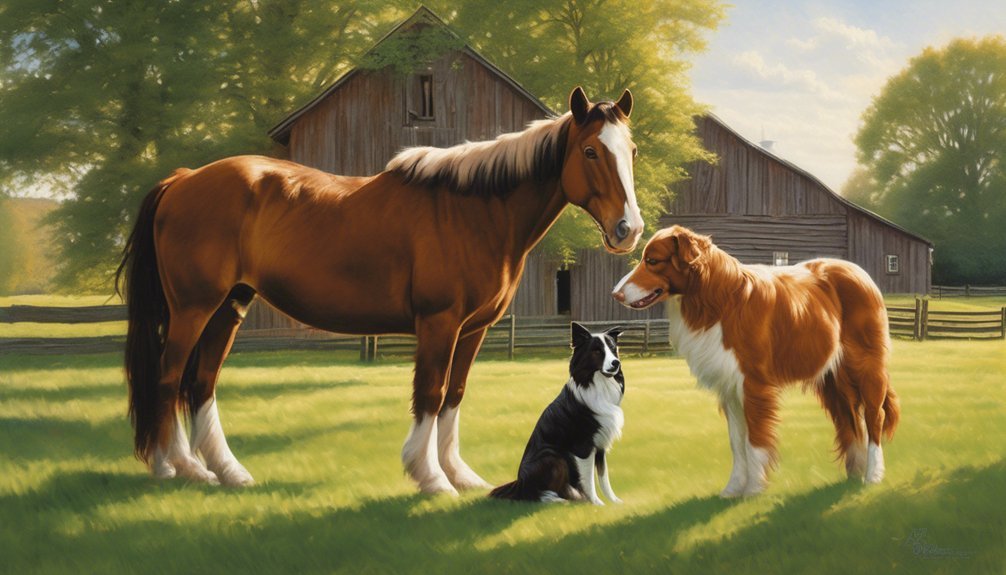
Throughout history, horses and dogs have forged an invaluable partnership in agriculture, shaping the way farms and ranches operate.
These historic partnerships have played a crucial role in the agricultural evolution you experience today. Horses, with their strength and endurance, have helped you plow fields and transport goods, while dogs have provided companionship and protection.
You can't underestimate the bond formed as they worked alongside you, learning your routines and responding to your commands. This connection has allowed for smoother operations, reducing the workload on you and your family.
As you nurture this partnership, you'll find that understanding their needs and instincts enhances not only your productivity but also the joy of working together in harmony on the land you love.
Roles and Responsibilities: How Each Species Contributes
On your farm, horses and dogs play vital roles that enhance productivity and companionship.
Each species brings unique skills, from horses helping with heavy tasks to dogs managing livestock and providing loyalty.
Understanding how they work together can improve your operations and strengthen the bond you share with these remarkable animals.
Working Together on Farms
While each animal on a farm plays a distinct role, horses and dogs often work together to create a harmonious and efficient environment.
By understanding their unique strengths, you can implement effective teamwork strategies that highlight their mutual benefits.
Here's how they contribute:
- Herding: Dogs excel at gathering and guiding livestock, keeping them organized and safe.
- Transporting: Horses can carry loads or riders across vast areas, assisting in various tasks.
- Alertness: Dogs serve as excellent watchdogs, alerting you to potential threats, while horses can sense danger in their surroundings.
- Training: Both species can learn from each other, enhancing their skills and efficiency on the farm.
Together, these animals foster a productive atmosphere, making farm life more enjoyable and effective for everyone involved.
Companionship and Loyalty
The bond between horses and dogs on farms goes beyond mere work; it's rooted in companionship and loyalty that enhances their roles and responsibilities.
You'll notice how your horse and dog form a loyal friendship, providing each other with emotional support during long days. This connection fosters a sense of trust, allowing them to work harmoniously as a team.
When your dog keeps a watchful eye on the horse, and the horse remains calm and steady in return, it creates a safe and nurturing environment.
Their companionship isn't just beneficial for productivity; it brings warmth and joy to farm life. By nurturing this unique relationship, you strengthen their roles, ensuring they thrive together in both work and play.
Specialized Tasks and Skills
Understanding the specialized tasks and skills that horses and dogs bring to the farm reveals how each contributes uniquely to daily operations.
You'll find that horses often excel in heavy-lifting tasks, while dogs shine in herding and guarding. Proper task delegation based on their specialized training makes all the difference.
- Horses: Often used for transportation, pulling equipment, or even participating in competitions.
- Dogs: Trained to herd livestock, protect property, and assist in search-and-rescue efforts.
- Collaboration: Horses and dogs work together seamlessly, enhancing efficiency.
- Adaptability: Both animals can be trained for various roles, making them invaluable partners on the farm.
Embracing their unique skills fosters a harmonious and productive environment.
Training Techniques: Building Trust and Cooperation
Building trust and cooperation between you and your horses or dogs is essential for effective training and harmonious interactions on the farm or ranch.
Start with simple trust exercises, like gentle grooming or hand-feeding, to foster a bond. These moments help your animal associate you with positive experiences.
Incorporate cooperative tasks, such as leading your horse through an obstacle or teaching your dog to retrieve items, to strengthen teamwork.
Use positive reinforcement consistently; praise and treats go a long way in building confidence.
Remember, patience is key. As you both learn and grow together, you'll not only enhance skills but also create a lasting relationship based on mutual respect and understanding.
Embrace the journey, and enjoy every moment!
Herding Dynamics: The Horse and Dog Partnership in Action
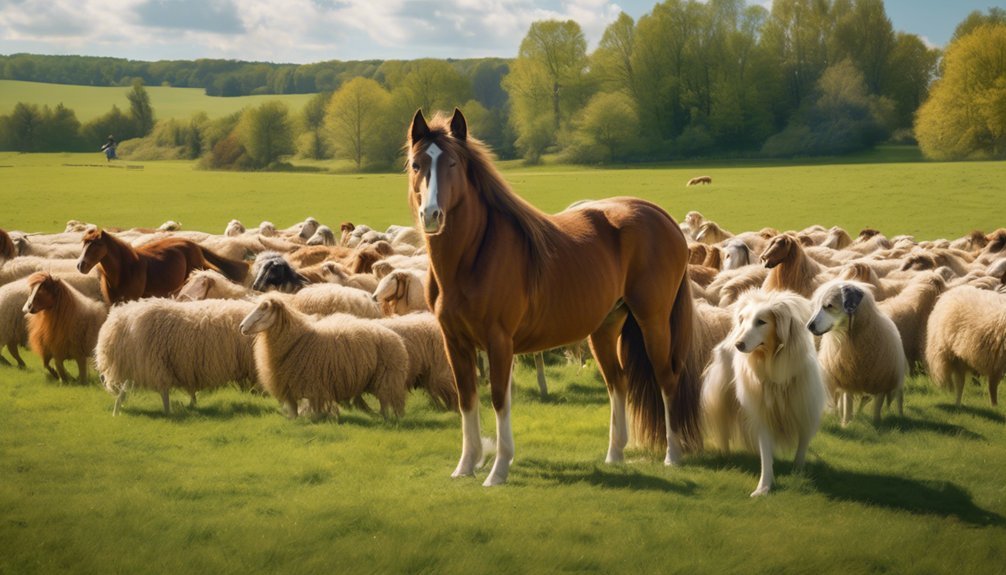
When you observe the partnership between horses and dogs on farms and ranches, it's clear that their herding dynamics play a vital role in managing livestock.
These animals work together, utilizing their unique herding techniques and animal instincts to guide and control herds efficiently.
- Horses provide strength and a calming presence, while dogs bring agility and sharp focus.
- Together, they communicate through body language and sound, creating a seamless flow.
- Each animal respects the other's role, fostering trust and cooperation.
- Their teamwork reduces stress in the herd, enhancing overall productivity.
Understanding this partnership not only highlights their individual skills but also showcases the bond that forms through shared purpose and experience on the ranch.
Companionship and Social Interaction on the Ranch
Companionship on the ranch goes beyond mere utility; it fosters a sense of community among animals and humans alike. Horses and dogs share a unique bond, marked by playful interactions that lighten the day. Watching them engage can lift your spirits, reminding you of the joy in simple moments.
| Aspect | Description |
|---|---|
| Playful Interactions | Dogs chase horses in a light-hearted manner, creating laughter. |
| Emotional Support | Both animals offer comfort during tough times, enhancing mental well-being. |
| Shared Activities | Together, they participate in daily ranch tasks, strengthening their bond. |
| Social Learning | They learn from each other, improving their skills through interaction. |
| Community Feeling | Their companionship brings a sense of belonging to the ranch environment. |
Embracing these relationships enriches your ranch experience, creating lasting memories.
The Importance of Communication Between Horses and Dogs
Observing the playful interactions between horses and dogs reveals how vital their communication is on the ranch.
These animals rely on non-verbal cues to build a bond and ensure safety. Understanding their unique ways of expressing themselves fosters mutual understanding and harmony.
- Horses may nicker or swish their tails, signaling comfort or discomfort.
- Dogs often use body language, like wagging tails or playful barks, to engage horses.
- Eye contact can strengthen their connection, as both species recognize intent and emotion.
- Mutual respect arises when they learn to interpret each other's signals.
Challenges and Solutions in Maintaining Harmony on Farms
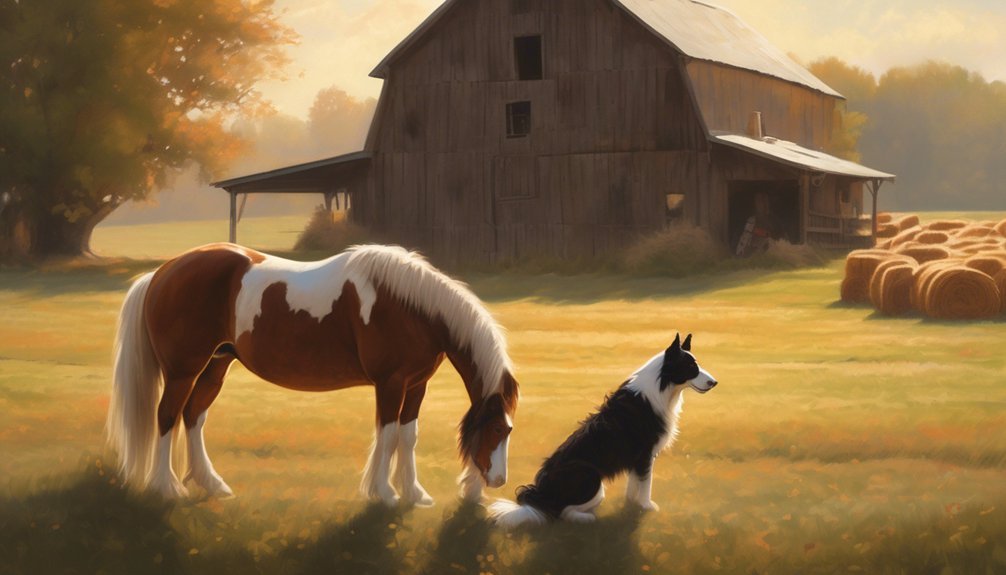
Maintaining harmony on farms can be challenging, especially when managing the interactions between horses and dogs. Behavioral conflicts often arise due to misunderstandings or territorial instincts.
To reduce these tensions, it's crucial to create a structured environment where both animals feel secure. Identify and minimize environmental stressors, such as loud noises or sudden movements, that might trigger anxiety.
Regular training sessions for both horses and dogs can foster mutual respect and understanding, helping them coexist peacefully. Establish consistent routines and supervised interactions to reinforce positive behavior.
Frequently Asked Questions
Can Horses and Dogs Form Friendships Outside of Work Responsibilities?
Absolutely! Horses and dogs can form genuine friendships through social bonding and playful interactions. You'll notice them sharing space, grooming each other, and engaging in fun games, creating a unique bond that transcends their work.
What Breeds of Dogs Are Best for Working With Horses?
When you're choosing a dog for working with horses, consider breeds like Border Collies and Australian Shepherds. These intelligent, energetic companions excel in herding, making them perfect partners for your equine adventures and daily tasks.
How Do Weather Conditions Affect Horse and Dog Interactions?
Weather conditions significantly influence your horse and dog interactions. Temperature effects can alter their energy levels and seasonal behavior, leading to more playful exchanges in mild weather or cautious interactions during extreme heat or cold.
Are There Specific Health Concerns for Horses and Dogs on Farms?
Did you know that around 80% of horses and dogs on farms face health risks from parasites? You'll need effective parasite management and vaccination protocols to keep them healthy and thriving in their environment.
How Can Owners Promote Positive Play Between Horses and Dogs?
To promote positive play between horses and dogs, plan engaging playtime activities that suit both animals' energy levels. Use supervision techniques, like leashes for dogs, to ensure safety while they interact and build a bond.
Conclusion
In the intricate dance of farm life, horses and dogs aren't just coworkers; they're partners in a shared purpose. Their unique skills complement each other, creating a synergy that enhances productivity and fosters a sense of community. By understanding their roles and nurturing their bond through trust and communication, you can cultivate a harmonious environment where both species thrive. Ultimately, the strength of their relationship mirrors the dedication you bring to your ranch, making every day a testament to teamwork.




